|
Maha Saman Devalaya:
Jewel of the Sabaragamuwa Province
Story and pictures by Mahil Wijesinghe
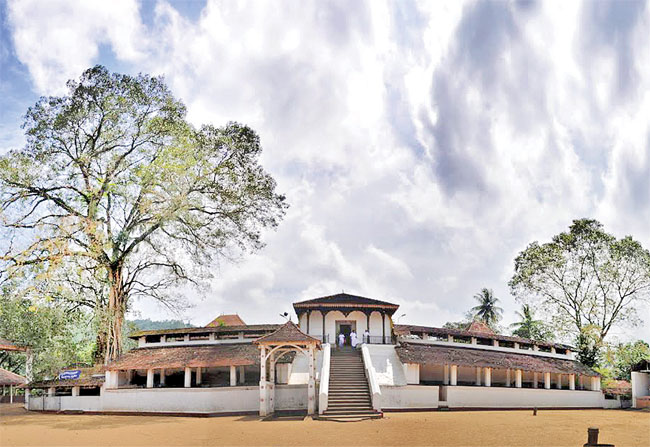 Sixty-five year old Janis and thirty year old Siripala wait till
September every year. The pair has a special duty each year for the
Peramune Rajakariya (frontline work). Every year, a few days prior to
commencing the Perahera, the pair who are in charge of Mahabamba Kolama,
start making the structure by first creating a bamboo skeleton of the
body and hands. They then fix the mask onto the skeleton and dress it up
in colourful cloths. Sixty-five year old Janis and thirty year old Siripala wait till
September every year. The pair has a special duty each year for the
Peramune Rajakariya (frontline work). Every year, a few days prior to
commencing the Perahera, the pair who are in charge of Mahabamba Kolama,
start making the structure by first creating a bamboo skeleton of the
body and hands. They then fix the mask onto the skeleton and dress it up
in colourful cloths.
The energetic link between the two leads to Mahabamba, donning on the
frame, walking and rotating it each night of the Perahera, while his
companion walks alongside, instructing him about what to do and where to
go. Like Janis and Siripala, hundreds of people have their duty to
perform at the Perahera which takes place five days in the month of
September in about three acres of the Maha Saman Devale of Saparagamuwa.
For five days in the third week of September, the premises of the
Maha Saman Devale get magically transformed by the ancient pageantry of
the spectacular Maha Saman Devale Perahera. The annual Perahera is a
colourful devotional display that honours God Sumana Saman who is
believed to be the guardian deity of Sri Pada or Adam’s Peak. The
Perahera is a tradition that goes back many centuries and is considered
second only to the Esala Perahera in Kandy in terms of reverence.
Rituals
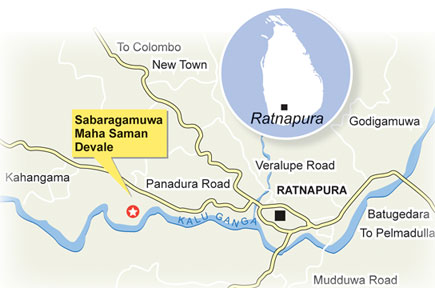 Preceding the Maha Perahera are several rituals performed according
to auspicious times, namely the Pirith ceremony, Kap Sitaveema, Kumbal
Perahera and Dewala Perahera, which takes a total of 13 days to
complete. Keeping more with traditions than rituals are announced by
firing the Portuguese muzzle loaded cannon in the Devale. And following
the Maha Perahera is the Diya Kapeema (water cutting) at Kalu Ganga and
Daval Perahera (Day Perahera) which concludes the pageant. Preceding the Maha Perahera are several rituals performed according
to auspicious times, namely the Pirith ceremony, Kap Sitaveema, Kumbal
Perahera and Dewala Perahera, which takes a total of 13 days to
complete. Keeping more with traditions than rituals are announced by
firing the Portuguese muzzle loaded cannon in the Devale. And following
the Maha Perahera is the Diya Kapeema (water cutting) at Kalu Ganga and
Daval Perahera (Day Perahera) which concludes the pageant.
The Perahera showcases the observance of age-old customs and rituals
dedicated to God Sumana Saman and portrays certain aspects of the
Sinhala Buddhist culture, interwoven with the performing arts of the
province that are strongly influenced by its folk traditions. The
Perahera has also given a platform to certain art forms, which were on
the wane, owning to the lack of an appreciative audience and vanishing
generations.
|
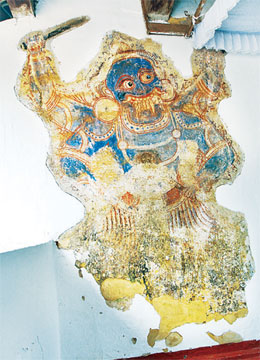
Only remaining ancient wall painting of the Devale, a figure
of a demon. |
Those watching the Perahera, especially children, are mesmerised by
the ‘Mahabamba Kolama, an inherited feature in Sabaragamuwa that can
only be seen at the Saman Devale Perahera. The huge (around 15 feet
high), colourfully dressed, two faced figure of Mahabamba, serene on one
side and fiercely demonic on the other, is a remarkable feature at this
Perahera. Legend has it that the huge figure depicts the character of
King Rajasingha I of Sitawaka.
The entire Devale premises is packed with people and the excitement
grows as the dancers take turns to swirl and twirl and bring the whole
area alive with sounds and twirling colours. More elephants join the
drum beats as the drum beats echo and more people join to view the
Perahera.
The three-storeyed Maha Saman Devale of Saparagamuwa stands majestic
on a hillock on the bank of the meandering Kalu Ganga. Located five
kilometres from Ratnapura city on Ratnapura-Panadura highway, the Saman
Devale can also be accessed via Horana, Avissawella and Pelmadulla.
|
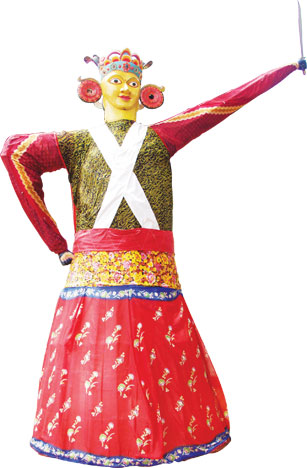
The impressive Mahabamba figure at the Devale ground. |
Before the commencement of the annual Perahera, we visited the
historic Maha Saman Devale and found the place busy. Walking around the
serene setting of the Devale, we saw a gorgeous view of the mountaintop
of Sri Pada that made the adobe of God Sumana Saman, who carries a white
lotus flower standing behind a tusker.
The story goes when Yaksha, Naga and Deva clans ruled the island, the
inhabitants in Saparagamuwa now known as Sabaragamuwa, who belonged to
the Deva clan was represented by a kind leader by the name of Sumana.
Following the visit of Buddha, he became a devout follower and requested
the Buddha to place his footprint on a gemstone atop Sri Pada for
worship. After Sumana’s passing away, he was deified and remained a
symbol of peace and tranquility due to his meritorious deeds.
According to the historical records, an interesting narration
interwoven with construction of the Devale, during the reign of King
Parakramabahu II (1236-1270) of the Dambadeniya Kingdom, the royal
treasury was reduced to zero and the King sought alternative ways to
obtain riches to fill the treasury.
On this quest, the King’s chief minister, Arya Kamadeva came to
Ratnapura and to the then Saparagrama Viharaya or Saman Viharaya. Upon
seeing a statue of God Sumana Saman and knowing that he is the deity
that influences the area, the Minister made a vow to build a shrine if
he was able to find gems to fill the treasury. Soon after he found a
trove of gems and in fulfillment of his vow he built the Devale where
the Saman Viharaya stood.
|
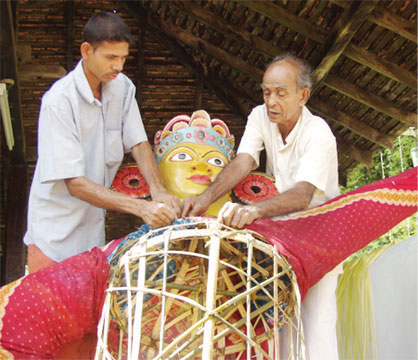
Dressing up the Mahabamba figure |
Through the times, the Devale had remained a place of devotion
receiving much patronage from kings who ruled the kingdoms of Kotte,
Seethawaka and Kandy.
When the Tooth Relic of the Buddha was hidden in a
maize grinding stone at the Delgamuwa temple in Kuruwita (The Sunday
Observer recently featured this story) King Rajasingha I has brought the
Tooth Relic to the Saman Devale on 11 consecutive years to hold the
Dalada Perahera.
|
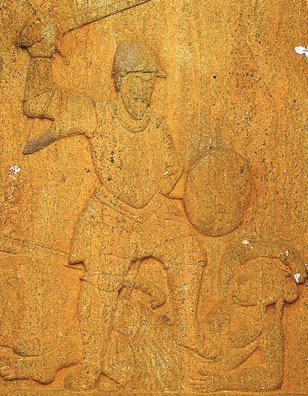
A stone emblem of a Portuguese soldier and inscription in
the
Devale ground |
Walking along the much spacious Devale upper and lower terraces
evidence remains that the place was once occupied by the Portuguese, who
ruled the area for 43 years. Ending their occupation, King Rajasingha II
(1635-1687) was able reclaim the area, constructing the Devale,
introducing the characteristic architecture of the Kandyan Kingdom.
Terrace
Through the Devale ground we made our way up to the upper terrace
climbing huge stone-made steps leading towards the quite long three-storeyed
shrine of God Sumana Saman. The beautiful Makara Thorana adores the
entrance to the shrine where a huge illustration of God Sumana Saman
hangs inside the shrine. And inside the walls of the main shrine room
there are indications of wall paintings belonging to Kandyan period.
Tragically, the wall paintings that once adored the walls of the
Devale have been whitewashed long ago, erasing the priceless paintings.
What remains today is only a huge figure of a fierce looking demon with
an elephant calf hanging from his teeth. At the upper terrace before
entering the Devale shrine, we walked to the image house of Buddha which
houses a seated Buddha statue belonging to the Kandyan period.
Furthermore, a few yards further inside, amidst white jasmine flower
bushes, there lie a deep well and several buildings which are occupied
by Kapuralas at present. In the corner of the left side of the Devale
stands ancient tall Bo-tree, a small Devale and a brick built small
Stupa with pillars.
A much spacious lower terrace strew with sands in the Devale is use
for dressing elephants during the Perahera season. Some ruined remnants
of antiquity such as stone carved pillars lie half buried scattered in
the ground while a stone emblem of a Portuguese soldier probably
trampling a local soldier and an inscription below the carving can still
be seen within the tile roofed verandah of the lower terrace.
|
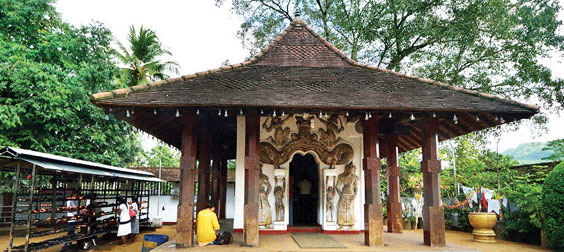
An image house dedicated to Buddha at the Devale. |
A large number of visitors throng the Devale daily for Poojas
carrying Pooja baskets with fruits lined up in a passage leading to the
shrine room to get blessings and fulfill the hopes and vows from the God
Sumana Saman. A newly constructed museum at the Devale holds an
impressive collection of ruins found from the Kalu Ganga. It is believed
that the ancient Devale has been once destroyed and thrown into the
river where the remnants of bygone era are still hidden beneath of the
depths. Some of the findings are exhibited in the museum.
This year’s Perahera starts tomorrow and will continue till September
16. All Perahera programmes are overseen by Kamal Ratwatte, incumbent
Basnayake Nilame, the Chief Lay Custodian of the Devale. |

